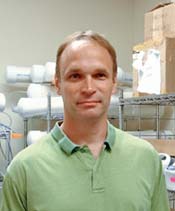 |
 |
| current issue |  | past issues |  | send a letter/news |  | address update |  | advertise |  | about us |  | alumni home |
Features
|
The First UROP Grant Recipients
Where are they now? |
Return to The First UROP Grant Recipients |
Scott Wudyka '88
Major: mechanical engineering
Job title: Systems R&D Manager, Covidien
Hometown: Marlborough, Mass.
 Scott Wudyka '88 |
What have you been doing since graduation, and what are you doing now?
After graduating in 1988, in a tight job market, I was lucky enough to find a job very quickly in the field related to my Senior Project, working for Hottinger Baldwin Measurements (HBM). HBM is a strain gage load cell company which supplies sensors to scale and other force measuring companies. As a Manufacturing Engineer in a small company, I had great opportunities to work in many capacities including product support and development, application engineering and production management. Things were different back then. My cubicle mates smoked right next to me. I still remember my dual floppy drive 8086 PC. Yes, two floppies, how high tech can you get!
After nine years I again lucked out and found my way into the medical device industry working for Nova Biomedical in Waltham, MA. Nova, a blood gas and electrolyte analyzer company, had, as a new business growth initiative, aligned themselves with a couple dozen new product development startup firms looking for manufacturing and commercialization help. In the three years there I ran several programs in the far flung and unrelated areas of corneal topography, immunoassay analysis, automated slide staining and all-mechanical infusion.
In 2000 I began my career with Covidien, formerly Tyco Healthcare, in medical device new product development. At first, as the primary manufacturing liaison, I worked with plants and contract manufacturers. Soon I was running development projects and having a lot of fun with it, but had to deal with the reality that not all products make it to market. In my case, none of them did. Undaunted, in 2010 we were finally able to break through with the launch of the Kendall SCD(TM) 700 series system. The device helps in the prevention of Deep Vein Thrombosis and Pulmonary Embolism, the most preventable cause of death in hospitals today.
In the meantime, I was able to have a personal life. I married Amie in 1991. We just celebrated our 20th year of marriage. We have a 10 year old boy, named Christopher. We live in Marlborough, Massachusetts, currently in our third house. I have kept myself busy with lots of DIY projects, woodworking, boating and homebrewing.
Your UROP project was entitled "Design and Construction of a Strain Gage Load Cell." Can you tell us what you did, and what you got out of it?
Working with Dan Therrien, we developed a load cell system that, at least in theory, was meant to monitor the dynamic forces generated during the machining of parts on a three axis milling machine. The system measured forces in three orthogonal directions. We agonized over design details as long as we could to feel we had it right, before making it. It was machined to our exacting specifications at the UNH machine shop. We applied strain gages, probably not so precisely, and wired our Wheatstone bridge circuits. After much troubleshooting and resoldering of wires, we got as far as to confirm that the load cell had output in response to an applied force. What a great victory.
Perhaps it is easy for me to look back with a critical eye, having worked in the load cell industry immediately thereafter. I know we missed some critical details of how a system like this would have to work in the actual application. Obtaining more knowledge of the machining process and the expected loads and vibration frequencies, for instance may have been a big help. Regardless, Dan and I had great times working on the project. We had to work together as a team, achieve an outcome, stay in budget and manage our time. What great preparation for two young engineers preparing to start their engineering careers.
Did your research have an impact on what you did later?
For me, the most substantial learning from this project was how critical it is to fully understand the application and the customer expectation before attempting to develop a product or solution. As I mentioned earlier, I worked on many new product development efforts that did not make it to market. In a couple of those instances, it became clear at some time that the product under development would not meet the needs of the customer or could actually detract from the current customer satisfaction. The new products were good ideas, but without proper understanding of the application and customer needs we could have caused a negative effect on our customers. Instead, we were honest with ourselves and stopped the projects before completion. This can be difficult, since teams invest so much of their time and effort and become emotionally attached to a project. Having the discipline to walk away at the right time can be just as important as having good ideas.
What do you remember about being on the cover of the Alumnus (assuming you remember it)?
Being on the cover of the Alumnus initially didn't have a big impact on me. Understandably, I was busy with a new job, moving out of my parents' home and beginning a new life. As time went on, though, every time I saw the cover, which to this day is still on my Mom's refrigerator, I realize how special it really was. It brings back the memories of those times, the project and how proud I am of my time at UNH.
< Previous recipient Next recipient >
Back to the '88 UROP stories
blog comments powered by Disqus

